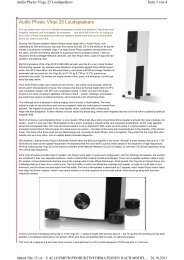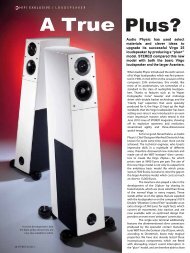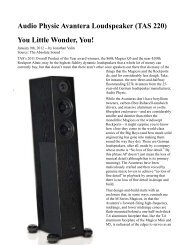Paradigm Atom Monitor v.7 Loudspeakers
Paradigm Atom Monitor v.7 Loudspeakers
Paradigm Atom Monitor v.7 Loudspeakers
Create successful ePaper yourself
Turn your PDF publications into a flip-book with our unique Google optimized e-Paper software.
In one area, the <strong>Atom</strong> <strong>v.7</strong> floored me: its re-creation of the sound of the acoustic piano. To assess how well a speaker<br />
does this, I use Glenn Gould’s A State of Wonder: The Complete Goldberg Variations of J.S. Bach 1955 & 1981 (CD,<br />
Sony Classical 87703); and Ola Gjeilo’s Stone Rose (CD/SACD, 2L 2L-048-SACD). The <strong>Atom</strong> <strong>v.7</strong>’s top end was<br />
prominent, but never excessive or bright; instead, its superb clarity up top made the instrument sound really alive.<br />
Mostly, though, it was the low end of Gjeilo’s piano that took me aback -- it sounded fuller and richer, with more detail,<br />
than I ever thought so small a speaker could manage. I don’t want to overstate the <strong>Atom</strong> <strong>v.7</strong>’s bass output -- it’s<br />
definitely not a full-range design -- but I don’t want to understate it either: this pintsize speaker sounded robust.<br />
With the Goldberg CD, it wasn’t the fullness or richness of the bass but, instead, the way the <strong>Atom</strong> <strong>v.7</strong> revealed the<br />
incisiveness and attack of Gould’s rapid-fire playing. The <strong>v.7</strong>’s sound was so detailed and well articulated that I’m sure<br />
most people unaware of its price would think they were hearing a set of larger speakers costing well over a grand. The<br />
<strong>Atom</strong> <strong>v.7</strong> offered so much music for so little money -- something I can’t always say about the really expensive stuff. I<br />
was impressed.<br />
Comparisons<br />
It was interesting to replace the Audioengine P4 speakers ($249/pair) in my smaller system with the <strong>Atom</strong> <strong>Monitor</strong><br />
<strong>v.7</strong>s. The jury is out on which speaker looks better -- the P4’s rounded edges and bamboo finish give it a unique look -<br />
- but there’s no question that the <strong>Atom</strong> <strong>v.7</strong> is more substantially built. The <strong>v.7</strong>’s cabinet is at least 20% bigger, its<br />
woofer is at least 1” larger in diameter (which, with the bigger cabinet, means deeper bass), and both drivers look<br />
more advanced and high-tech. That’s not to dis the P4 -- it costs more than a third less than the <strong>Paradigm</strong>, and it’s<br />
intended to be used in a bedroom, living room, or office. In an office, it’s likely to be used on a desk, where its smaller<br />
size and unique appearance will be more welcome than the bigger, boxier <strong>Atom</strong> <strong>v.7</strong>.<br />
The two models’ sound qualities are also markedly different. The P4 is notable for sound that is very neutral and<br />
refined for the price -- for $249/pair, it’s a very good deal. But for $149 more, the <strong>Atom</strong> <strong>v.7</strong> offers a bigger, richer, fuller<br />
sound, with far more impact in the bass, even when driven by the little 22Wpc N22 amp. And in terms of spaciousness<br />
there was no contest -- the P4s’ sound was always easily identified as emanating from and slightly around the<br />
speakers’ cabinets, whereas the <strong>Paradigm</strong>s’ sound seemed to come from everywhere but the cabinets. The P4’s<br />
highs sounded clean, but the <strong>Atom</strong> <strong>v.7</strong>’s highs were far more clear, extended, and lively. My wife listens to a lot of<br />
guitar-dominated Latin music through our second system, and there was no question that plucked guitar notes<br />
sounded much cleaner and more refined through the <strong>Atom</strong>s. In fact, after the <strong>Paradigm</strong>s had been in the system a<br />
while, she didn’t want me to remove them. The <strong>Atom</strong> <strong>v.7</strong> also rendered voices and subtle details with much more<br />
clarity.<br />
If you can’t spend more than $250, or just want some decent-sounding, nice-looking speakers for your desktop, the P4<br />
is a good choice. But moving up to the <strong>Atom</strong> <strong>Monitor</strong> <strong>v.7</strong> offers a significant improvement in sound quality and gets<br />
you into the territory of real speakers -- speakers around which you can build a true high-end system.<br />
The Polk RTi A1 loudspeaker, which Aron Garrecht reviewed and praised last year, is one of those real speakers, and<br />
proved a more worthy opponent. I have a pair of them here and can back up Aron’s enthusiasm with my own -- the






